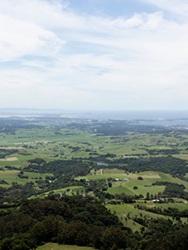Smarter Irrigation for Profit
The Smarter Irrigation for Profit - Phase 2 (SIP2) project is a partnership between the dairy, cotton, horticulture, rice and grain sectors, supported by funding from the Australian Government Department of Agriculture, Water and the Environment as part of its Rural R&D for Profit program and each of the industries involved.
The first phase of the project (SIP1) was conducted between 2015 and 2018. The outcomes were significant for the dairy industry in identifying irrigation management practices that were constraining optimal yield of pastures and crops on irrigated areas.
SIP1 measured the outcomes of amended irrigation strategies and technologies on five 'Optimisation Irrigation Dairy Farms' in Victoria, New South Wales, South Australia, Queensland and Western Australia. All SIP1 sites increased energy and water use efficiency, dry matter grown per hectare per day and the overall yield within a specified irrigation period.
These results were achieved by improving irrigation practices such as timing of start-up, using technologies to inform irrigation scheduling and conducting system and pump checks. SIP1 showed that improved water productivity hinged on “getting the basics right.”
SIP2 has been developed using the findings from SIP1. There are four dairy projects within SIP2 (2019 – 2022) with the collective aim to get the irrigation fundamentals right on farm, increase adoption of existing technologies and explore the potential of new strategies and technologies not yet adopted in dairy. These are:
- What's my yield gap? Maximising water productivity - Dairy Australia
- Beyond Water Smart – Tasmanian Institute of Agriculture
- Scaling irrigation management to support whole farm operations – Agriculture Victoria
- Precise real time automated irrigation for cotton and dairy – University of Southern Queensland and Tasmanian Institute of Agriculture
SIP2: The next phase for dairy
SIP2: What's my yield gap? Maximising water productivity
This project aims to fast-track adoption of SIP1 key findings through trials, measurement and benchmarking on 10 Dairy Optimisation Sites through the seven dairy regions on the mainland. Measures including yield and water/power efficiency will be determined by collecting data using standard water productivity and economic metrics across all sites.
All Australian dairy regions have businesses that use irrigation, but the types of application and agronomic systems are diverse. For this reason, new technologies and strategies are being trialled and evaluated in a local context, with input from farmers and service providers of the Dairy Optimisation Site reference group.
Measuring outcomes for dairy
To measure the dairy specific outcomes of the What’s my yield gap? Maximising Water productivity project, standard metrics and measurement equipment has been applied at each site. This will maximise industry-wide impact and assessment of the efficiency and production outcomes of adopting certain irrigation practices and innovations.
These include:
- Soil moisture monitors installed: capacitance probes, real-time telemetry and app-accessible reporting to monitor the effectiveness of irrigation and rainfall on soil moisture
- Irrigation system and pump evaluations: baseline versus improved system efficiencies, Yield monitoring on farm including using growth rate and yield measures to compare against satellite measurement systems including Pasture.io.
- Irrigation scheduling using IrriPasture, an online weather-based water balance calculator. IrriPasture has been further developed to include crops such as maize, sorghum and millet as well as lucern, shallow rooted perennial and annual pastures.
Below is the standard reporting table being used.
|
Dry Matter |
|
Water |
|
Energy |
|
|
DM production |
kgDM/ha |
Water Use |
ML |
Energy Use |
kWh |
|
Growth rate |
kgDM/ha/day |
Water costs |
Total costs($) |
Energy costs |
Total costs ($) |
|
|
|
Efficiency |
kgDM/ML |
Efficiency |
kWh/ML/mhead |
Dairy Australia is ensuring farmers have access to the latest information to achieve pasture and crop yield potential from irrigation water while improving input efficiency of water, power and labour to increase farm profit.
Catch Can Testing
Profitable Irrigation Pumping
Reducing emissions with moving water
System Maintenance
Benefits of an irrigation system maintenance check
System Maintenance Check-lists
Scroll to “Management and System Check-lists”
Improved flow on irrigation bays- benefit of spinner cuts
Irrigation scheduling
Advanced data-driven irrigation: Where are the losses?
What is evapotranspiration and how do I use it to schedule irrigations?
Soil moisture monitoring
Dairy Australia Soil Moisture Monitoring Information Sheet
Irrigation New Zealand Soil Moisture Monitoring Guide
Useful websites
Local Dairy Optimisation Sites
Western Australia – Dardanup
Contact: Sam Taylor on sam@agvivo.com.au
South Australia – Mt Compass
Contact: Cathy Ashby on cathy.ashby@dairyaustralia.com.au
South Australia – Mt Gambier
Contact: Cathy Ashby on cathy.ashby@dairyaustralia.com.au
Western Victoria – Mepunga East
Contact: Graeme Ward on graeme.ward57@bigpond.com
Murray Dairy – Tongala
Contact: Shane Byrne on shane.byrne@dairyaustralia.com.au
Gippsland - MID - Cobains
Contact: Robyn McLean on robyn.mclean@gippsdairy.com.au or Billy Marshall on billy.marshall@agriculture.vic.gov.au
Gippsland – Yarram
Contact: Robyn McLean on robyn.mclean@gippsdairy.com.au or Billy Marshall on billy.marshall@agriculture.vic.gov.au
NSW – Bega
Contact: Kym Revington on revington.techservices@gmail.com
NSW – Tocal
Contact: Peter Smith on sapphireirrig@gmail.com
NSW – Coraki
Contact: Ross Warren on Ross.Warren@daf.qld.gov.au
Pre-season checklists
Pre-season checklist
-
Pre-season Checklist Bike Shift IrrigationPDF, 192.63 KB
-
Pre-season Checklist Travelling IrrigatorsPDF, 211.98 KB
-
Pre-season Checklist Centre Pivots and LateralsPDF, 335.04 KB
-
Pre-season Checklist K-Line IrrigationPDF, 198.58 KB
-
Pre-season Checklist Solid Set IrrigationPDF, 192.96 KB
-
Soil Moisture Monitoring CheckPDF, 249.39 KB
Fact sheets
Factsheets
-
Determining readily available water from soil texturePDF, 500.21 KB
-
Irrigating to avoid the “Green Drought”PDF, 566.35 KB
-
Using soil moisture monitoring to schedule irrigationPDF, 675.23 KB
-
Using weather forecasts to schedule irrigationPDF, 381.4 KB
-
Optimising irrigation system performancePDF, 423.41 KB
-
Beyond water smart - Advancing Dairy Irrigation System PerformancePDF, 316.23 KB
-
Scaling irrigation management to support whole farm operationsPDF, 429.82 KB
-
Smarter irrigation for profit dairy optimisationPDF, 1.75 MB
-
Australian Dairy Irrigation GuidePDF, 4.95 MB
Expert videos
-
James Hills, researcher, Tasmanian Institute of Agriculture
-
Lisa Menhenett, Regional Extension Officer, Murray Dairy
-
Andrew Tyler, dairy farmer, northern Victoria
-
Amjed Hussain, scientist, Agriculture Victoria





